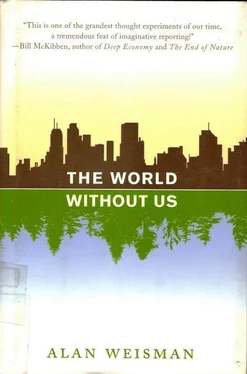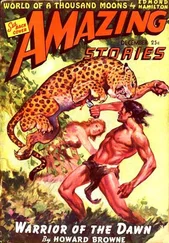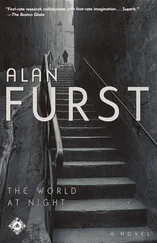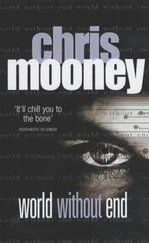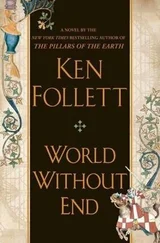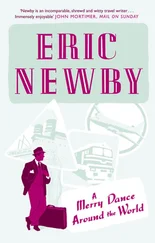Other than the back-and-forth of pigeons, all that moves is the creaky rotor of one last functioning windmill. Hotels—mute and windowless, some with balconies that have fallen, precipitating cascades of damage below—still line the riviera that once aspired to be Cannes or Acapulco. At this point, all parties agree, none is salvageable. Nothing is. To someday once again lure tourists, Varosha will have to be bulldozed and begun anew.
In the meantime, nature continues its reclamation project. Feral geraniums and philodendrons emerge from missing roofs and pour down exterior walls. Flame trees, chinaberries, and thickets of hibiscus, oleander, and passion lilac sprout from nooks where indoors and outdoors now blend. Houses disappear under magenta mounds of bougainvillaea. Lizards and whip snakes skitter through stands of wild asparagus, prickly pear, and six-foot grasses. A spreading ground cover of lemon grass sweetens the air. At night, the darkened beachfront, free of moonlight bathers, crawls with nesting loggerhead and green sea turtles.

THE ISLAND OF Cyprus is shaped like a skillet, with its long handle extended toward the Syrian shore. Its pan is gridded with two mountain ranges oriented east-west and divided by a wide central basin—and by the Green Line, with one sierra on each side. The mountains were once covered with Aleppo and Corsican pines, oaks, and cedars. A cypress and juniper forest filled the entire central plain between the two ranges. Olive, almond, and carob trees grew on the arid seaward slopes. At the end of the Pleistocene, dwarf elephants the size of cows and pygmy hippopotamuses no bigger than farmyard swine roamed among these trees. Since Cyprus originally rose from the sea, unconnected to the three continents that surround it, both species apparently arrived by swimming. They were followed by humans about 10,000 years ago. At least one archaeological site suggests that the last pygmy hippo was killed and cooked by Homo sapiens hunters.
The trees of Cyprus were prized by Assyrian, Phoenician, and Roman boat builders; during the Crusades, most of them disappeared into the warships of Richard the Lionhearted. By then, the goat population was so large that the plains remained treeless. During the 20th century, plantations of umbrella pines were introduced to try to resuscitate former springs. However, in 1995, following a long drought, nearly all of them and the remaining native forests in the northern mountains exploded in a lightning inferno.
Journalist Metin Münir was too grieved to return again from Istanbul to face his native island in ashes, until a Turkish Cypriot horticulturist, Hikmet Uluçan, convinced him he needed to see what was happening. Once again, Münir found that flowers were renewing a Cyprus landscape: the burnt hillsides were blanketed with crimson poppies. Some poppy seeds, Uluçan told him, live 1,000 years or more, waiting for fire to clear trees away so they can bloom.
In the village of Lapta, high above the northern coastline, Hikmet Uluçan grows figs, cyclamens, cacti, and grapes, and reverently tends the oldest weeping mulberry in all Cyprus. His moustache, Vandyke beard, and remaining tufts of hair have whitened since he was forced to leave the South as a young man, where his father had a vineyard and raised sheep, almonds, olives, and lemons. Until the senseless feud that tore apart his island, 20 generations of Greeks and Turks had shared their valley. Then neighbors were clubbed to death. They found the smashed body of an old Turkish woman who had been grazing her goat, the bleating animal still tied to her wrist. It was barbaric, but Turks were also slaying Greeks. Murderous, mutual loathing between tribes was no more explicable, or complicated, than the genocidal urges of chimpanzees—a fact of nature that we humans, vainly or disingenuously, pretend our codes of civilization transcend.
From his garden, Hikmet can see down to the harbor at Kyrenia, guarded by a seventh-century Byzantine castle built atop Roman fortifications that preceded it. Crusaders and Venetians subsequently took it; then came Ottomans, then British, and now Turks were having a turn again. Today a museum, the castle holds one of the world’s rarest relics, a complete Greek merchant ship discovered in 1965, scuttled a mile off Kyrenia. When it went down, its hold was filled with millstones and hundreds of ceramic urns containing wine, olives, and almonds. Its cargo was heavy enough to mire it where currents buried it in mud. Carbon dating of the almonds it carried, likely picked in Cyprus only days earlier, shows that it sank about 2,300 years ago.
Shielded from oxygen, the ship’s Aleppo pine hull and timbers remained intact, although they had to be injected with polyethylene resins to keep from disintegrating once exposed to air. The boat builders had used nails of copper, also once plentiful on Cyprus, also impervious to rust. Equally well preserved are lead fishing weights and the ceramic urns whose varied styles reveal the Aegean ports of their origin.
The 10-foot-thick walls and curved towers of the castle where the ship is now displayed are of limestone quarried from the surrounding cliffs, bearing tiny fossils deposited when Cyprus was beneath the Mediterranean. Since the island was divided, however, the castle and the fine old stone carob warehouses of Kyrenia’s waterfront have all but disappeared behind unlovely infestations of casino hotels—gambling and loose currency laws being among the limited economic options open to a pariah nation.
Hikmet Uluçan drives east along Cyprus’s north coast, passing three more castles of native limestone rising from the jagged mountains that parallel the narrow road. Along the headlands and promontories overlooking the topaz Mediterranean are remains of stone villages, some of them 6,000 years old. Until recently, their terraces, half-buried walls, and jetties were also visible. Since 2003, however, yet another foreign incursion has assaulted the island’s profile. “The only consolation,” mourns Uluçan, “is that this one can’t last.”
Not crusaders, this time, but elderly British seeking the warmest retirement a middle-class pension can buy, led by a frenzy of developers who discovered in the quasi-country of Northern Cyprus the last cheap, untouched seafront property left anywhere north of Libya, with pliable zoning codes to match. Suddenly, bulldozers were scattering 500-year-old olive trees to scrape roads across hillsides. Waves of red-tiled roofs soon oscillated across the landscape, atop floor plans cloned repeatedly in poured concrete. Upon a tsunami of cash payoffs, properly agents surfed to shore astride English-language billboards that appended terms like “Estates,” “Hillside Villas,” “Seaside Villas,” and “Luxury Villas” to ancient Mediterranean place-names.
Prices from £40,000 to £100,000 ($75,000 to $185,000 U.S.) touched off a land rush that overwhelmed trifles such as title disputes by Greek Cypriots who still claimed to own much of the land. A Northern Cyprus environmental-protection trust vainly protested a new golf course by reminding people that they now had to import water from Turkey in giant vinyl bags; that municipal garbage tips were full; that the total lack of sewage treatment meant five times as much effluent would pour into the transparent sea.
Each month more steam shovels gobble coastline like famished brontosaurs, spitting out olive and carob trees along a widening blacktop now 30 miles east of Kyrenia, with no sign of stopping. The English language marches down the shore, dragging embarrassing architecture with it, one sign after another announcing the latest subdivision with a trust-inspiring British name, even as the seaside villas grow trashier: concrete painted, not stuccoed; fake-ceramic roof tiles made of tacky polymer; cornices and windows trimmed with faux stenciled stonework. When Hikmet Uluçan sees a pile of traditional yellow tiles lying in front of naked town house frames awaiting walls, he realizes that someone is ripping stone facing from local bridges and selling it to contractors.
Читать дальше
